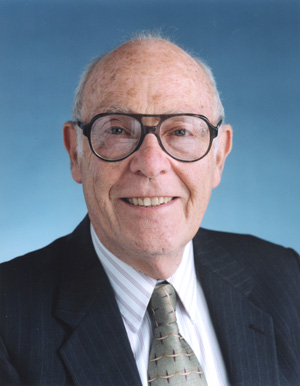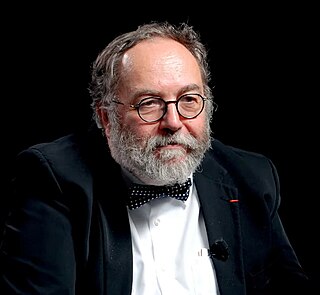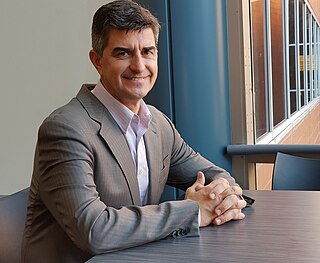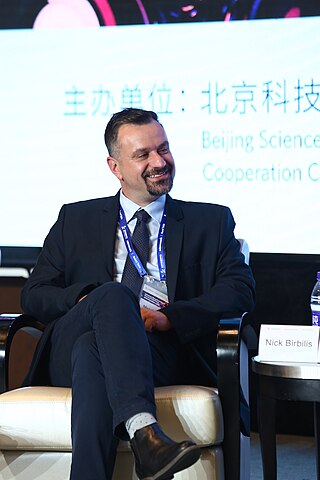Related Research Articles

Sumio Iijima is a Japanese physicist and inventor, often cited as the inventor of carbon nanotubes. Although carbon nanotubes had been observed prior to his "invention", Iijima's 1991 paper generated unprecedented interest in the carbon nanostructures and has since fueled intense research in the area of nanotechnology.

George David William Smith FRS, FIMMM, FInstP, FRSC, CEng is a materials scientist with special interest in the study of the microstructure, composition and properties of engineering materials at the atomic level. He invented, together with Alfred Cerezo and Terry Godfrey, the Atom-Probe Tomograph in 1988.

Arden Lee Bement Jr. is an American engineer and scientist and has served in executive positions in government, industry and academia.

John Werner Cahn was an American scientist and recipient of the 1998 National Medal of Science. Born in Cologne, Weimar Germany, he was a professor in the department of metallurgy at the Massachusetts Institute of Technology (MIT) from 1964 to 1978. From 1977, he held a position at the National Institute of Standards and Technology. Cahn had a profound influence on the course of materials research during his career. One of the foremost authorities on thermodynamics, Cahn applied the basic laws of thermodynamics to describe and predict a wide range of physical phenomena.
Zenon Jan Pudlowski (Pudłowski) is an engineer and educator. He is currently director of the World Institute for Engineering and Technology Education based in Melbourne, Australia. He is also a visiting professor at Slovak University of Technology in Bratislava, Bratislava, Slovakia.

Tanjore Ramachandra Anantharaman was one of India's pre-eminent metallurgists and materials scientists.

Michael Grätzel is a professor at the École Polytechnique Fédérale de Lausanne where he directs the Laboratory of Photonics and Interfaces. He pioneered research on energy and electron transfer reactions in mesoscopic-materials and their optoelectronic applications. He co-invented with Brian O'Regan the Grätzel cell in 1988.
Olusegun O. Adewoye (1947–2015) was the director general and chief executive of the National Agency for Science and Engineering Infrastructure (NASENI), Abuja, Nigeria.
Sir Lindesay Clark was a renowned Australian mining engineer and company director. He had a profound influence on the metallurgical industry in Australia and on the attitudes of many of its later leaders. Over four decades, he was instrumental in transforming Western Mining Corporation from a small gold miner into a diversified giant.

Yves Bréchet is a physicist, specialist of materials science, former High Commissioner for Atomic Energy of France, current Scientific Director of Saint Gobain, professor (part-time) at Monash University, and a member of the French Academy of Sciences.

Sir Harshad"Harry"Kumar Dharamshi Hansraj Bhadeshia is an Indian-British metallurgist and Emeritus Tata Steel Professor of Metallurgy at the University of Cambridge. In 2022 he joined Queen Mary University of London as Professor of Metallurgy.
Palle Rama Rao FREng is an Indian scientist noted for his contribution to the field of Physical and Mechanical Metallurgy. He has collaborated and conducted research activities for over dozen universities and associations all over India and abroad. He has been honoured with the titles of Padma Vibhushan in 2011 by president of India for his contributions to scientific community. He is acting as the chairman, Governing Council, International Advanced Research Centre for Powder Metallurgy & New Materials (ARCI), Hyderabad.

Yury Georgievich Gogotsi is a Ukrainian scientist in the field of material chemistry, professor at Drexel University, Philadelphia, PA since the year 2000 in the fields of Materials Science and Engineering and Nanotechnology. Distinguished University and Trustee Chair professor of materials science at Drexel University — director of the A.J. Drexel Nanotechnology Institute.
Bal Raj Nijhawan, was an Indian metallurgist, author and the first Director of Indian origin of the National Metallurgical Laboratory, Council of Scientific and Industrial Research (CSIR). He was a recipient of Shanti Swarup Bhatnagar Prize, the highest Indian science award, which he received in 1964 in the Engineering sciences category. The Government of India honoured him in 1958, with the award of Padma Shri, the fourth highest Indian civilian award for his services to the nation.
Bhakta B. Rath is an Indian American material physicist and head of the Materials Science and Component Technology of the United States Naval Research Laboratory (NRL), the corporate research laboratory for the United States Navy and the United States Marine Corps. He is the chief administrative officer for program planning, interdisciplinary coordination, supervision and control of research and is the associate director of research for Materials Science and Component Technology at NRL.
Kuppuswamy Anantha Padmanabhan is an Indian academician well known for his contributions in the field of materials & metallurgical science and engineering. In particular, he is well renowned for his contributions to superplasticity. He is currently professor of eminence (honorary), Anna University, Chennai; member, Research and Innovation Advisory Board, TCS and a research advisor to TCS and Aditya Birla S&T Company. He is a former director of Indian Institute of Technology Kanpur and a former dean, academic research, IIT Madras, India. In 1994, he became the first Indian to receive the "Forschungspreis" of the Alexander von Humboldt Foundation, Germany. For his research contributions, the University of Cambridge, UK, conferred on him the highest academic degree ‘Sc.D’ in 1998, and he is the first Indian engineer/ materials specialist to be conferred this honour. He also served as the Mercator Professor of DFG at the Institute of Materials Physics, University of Münster, Germany.
Shrikant Lele is an Indian metallurgical engineer and a distinguished professor of Indian Institute of Technology (BHU) Varanasi. He is a former director of the Institute of Technology of the university (2002–05) and is known for his studies on structural metallurgy. He is credited with reportedly original work on X-ray diffraction effects, solid state and martensitic transformations as well as spinodal decomposition in alloys and electron diffraction from quasicrystals. His researches have been documented in several peer-reviewed articles; and Google Scholar the online article repository of Indian Academy of Sciences has listed 33 of them.
Dipankar Banerjee is an Indian physical metallurgist, materials engineer and a former chief controller of R&D at the Defence Research and Development Organization (DRDO). Known for his studies on titanium alloys, Banerjee is an elected fellow of all the three major Indian science academies namely Indian Academy of Sciences, Indian National Science Academy and National Academy of Sciences, India as well as the Indian National Academy of Engineering. The Council of Scientific and Industrial Research, the apex agency of the Government of India for scientific research, awarded him the Shanti Swarup Bhatnagar Prize for Science and Technology, one of the highest Indian science awards for his contributions to Engineering Sciences in 1993. He received the fourth highest Indian civilian honour of Padma Shri from the Government of India in 2005.

Nick Birbilis is an Australian engineer and academic. He is presently the Executive Dean of the Faculty of Science, Engineering, and Built Environment, at Deakin University. Birbilis was previously the Dean, and Deputy Dean of the College of Engineering and Computer Science at the Australian National University. He is of Greek-Australian background. Birbilis works in the field of materials science and engineering, having made contributions in the area of materials design, materials durability and materials characterisation. He is a Fellow of the Electrochemical Society (US), a Fellow of NACE (US), a fellow of Engineers Australia, a Fellow of the International Society of Electrochemistry (ISE)., and a Fellow of ASM International.

Terence G. Langdon is a scientist and an academic. He is a Professor of Materials Science at the University of Southampton, and a Professor of Engineering Emeritus at the University of Southern California.
References
- 1 2 3 "Professor Yuri Estrin: excellence in the area of physical metallurgy". 18 January 2010.
- 1 2 "Fellows of the Australian Academy of Science".
- ↑ "Yuri Estrin awarded Honorary Doctorate by Russian Academy of Sciences".
- ↑ "Thomson Reuters 2015 Citation Award" (PDF).
- ↑ "Nanotechnology researcher honoured". Monash University. 20 April 2012. Retrieved 7 November 2018.
- ↑ "Forschung ueber Grenzen hinaus".
- ↑ "Professor Yuri Estrin".